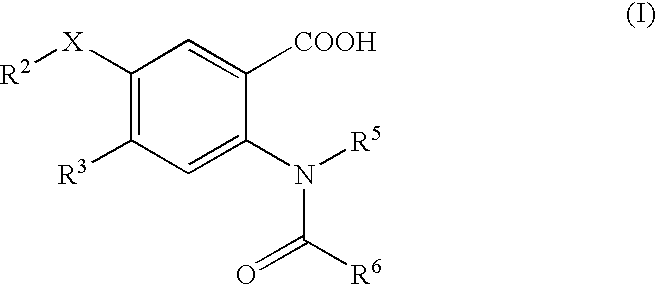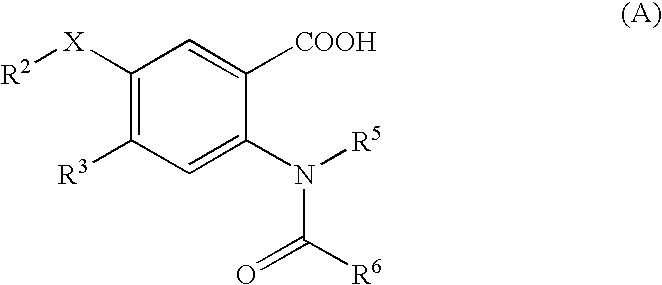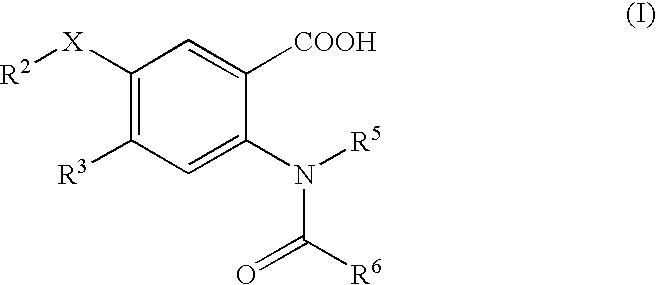Viral polymerase inhibitors
a polymerase inhibitor and polymerase technology, applied in the field of compound, composition and method of treatment of hepatitis c virus (hcv) infection, can solve the problems of ineffective treatment in reducing hcv rna to undetectable levels in many infected patients, intolerable side effects, etc., and achieves low to very low or even non-significant activity, inhibit rna synthesis
- Summary
- Abstract
- Description
- Claims
- Application Information
AI Technical Summary
Benefits of technology
Problems solved by technology
Method used
Image
Examples
example 1a
Preparation of Compound 1001
[0359]
[0360]Step 1a:
[0361]To a mixture of phenol (5.0 g, 53 mmol) and methyl-5-chloro-2-nitrobenzoate 1a1 (7.6 g, 35 mmol) in DMSO (20 mL) is added anhydrous K2CO3 (7.3 g, 53 mmol). The mixture is heated to 90° C. and stirred 6 hours. The mixture is diluted in water then extracted with EtOAc (×2). The combined organic extracts are washed with brine, dried over MgSO4, filtered and concentrated under reduced pressure.
[0362]Step 1b:
[0363]The crude diarylether is diluted in MeOH and 10% Pd(OH)2 / C (0.3 g) is added. The vessel is purged with H2 then is stirred overnight under 1 atm of H2. The mixture is filtered through a pad of celite then is concentrated in vacuo. To a mixture of the crude aniline in anhydrous Et2O (150 mL) is slowly added HCl (1 M in ether, 150 mL). The resulting solid hydrochloride salt 1a2 is collected by filtration and washed with excess ether and dried.
[0364]Step 2:
[0365]Reference: Abdel-Magid, A. F.; Carson, K. G.; Harris, B. D.; Maryan...
example 2a
Preparation of Intermediate 2a3
[0371]
[0372]Step 1:
[0373]The SNAr reaction between 2-trifluoromethylphenol and methyl-5-chloro-2-nitrobenzoate 1a1 to form diarylether 2a1 is performed as described in example 1A step 1a.
[0374]Step 2:
[0375]To a mixture of nitroarene 2a1 (780 mg, 2.3 mmol) in MeOH (20 mL) and AcOH (6 mL) is added iron powder (1.3 g, 23 mmol). The mixture is stirred for 30 minutes at 85° C. before being partitioned between EtOAc and saturated aqueous NaHCO3. The aqueous layer is separated and extracted again with EtOAc. The combined organic extracts are washed with water and brine. The organic phase is dried over MgSO4, filtered, and then concentrated under reduced pressure.
[0376]To a mixture of the crude aniline in Et2O and hexanes is added HCl (1.0 M in ether, 6 mL, 6 mmol). The resulting solid hydrochloride salt 2a2 is collected by filtration and washed with excess ether and dried.
[0377]Step 3:
[0378]Reductive amination to form i-Pr-aniline 2a3 is performed as describe...
example 3a
Method A
Preparation of Compound 1002
[0379]
[0380]Step 1a:
[0381]To a mixture of 2-methyl-4-thiazolecarboxylic acid 3a1 (27 mg, 0.17 mmol) and anhydrous DCE (1 mL) is added triphosgene (22 mg, 0.08 mmol) and 2,4,6-collidine (100 μl) and i-Pr-aniline 2a3 (35 mg, 0.10 mmol). The mixture is agitated on a J-Kem® orbital shaker (300 rpm) at 80° C. overnight. The mixture is concentrated under reduced pressure using a Savant™ speed-vac. The residue is taken up in EtOAc and washed with saturated aqueous NaHCO3 (×2) and brine. The solvent is removed under reduced pressure. The residue is taken up in DMSO then aqueous NaOH (10 N, 50 μL, 0.5 mmol) and water (180 μL) are added and the mixture is agitated on a J-Kem® orbital shaker (300 rpm) at RT overnight. The mixture is acidified with AcOH (200 μl) then injected onto a preparative HPLC to isolate compound 1002.
PUM
| Property | Measurement | Unit |
|---|---|---|
| Antimicrobial properties | aaaaa | aaaaa |
Abstract
Description
Claims
Application Information
 Login to View More
Login to View More - R&D
- Intellectual Property
- Life Sciences
- Materials
- Tech Scout
- Unparalleled Data Quality
- Higher Quality Content
- 60% Fewer Hallucinations
Browse by: Latest US Patents, China's latest patents, Technical Efficacy Thesaurus, Application Domain, Technology Topic, Popular Technical Reports.
© 2025 PatSnap. All rights reserved.Legal|Privacy policy|Modern Slavery Act Transparency Statement|Sitemap|About US| Contact US: help@patsnap.com



